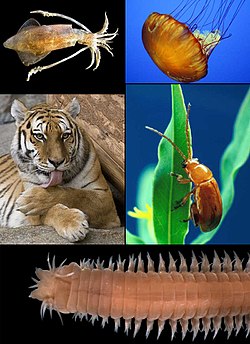This is an old revision of this page, as edited by Tablelajk3 (talk | contribs) at 13:16, 11 September 2007 (→References). The present address (URL) is a permanent link to this revision, which may differ significantly from the current revision.
Revision as of 13:16, 11 September 2007 by Tablelajk3 (talk | contribs) (→References)(diff) ← Previous revision | Latest revision (diff) | Newer revision → (diff)| This article needs additional citations for verification. Please help improve this article by adding citations to reliable sources in this article. Unsourced material may be challenged and removed. Find sources: "Animal" – news · newspapers · books · scholar · JSTOR (July 2007) (Learn how and when to remove this message) |
| Animals Temporal range: Ediacaran - Recent | |
|---|---|

| |
| Clockwise from top-left: Loligo vulgaris (a mollusk), Chrysaora quinquecirrha (a cnidarian), Aphthona flava (an arthropod), Eunereis longissima (an annelid), and Panthera tigris (a chordate). | |
| Scientific classification | |
| Domain: | Eukaryota |
| (unranked): | Opisthokonta |
| Kingdom: | Animalia Linnaeus, 1758 |
| Phyla | |
|
Subregnum Parazoa (alternatively)
| |

Animals are a major group of organisms, classified as the kingdom Animalia or Metazoa. In general they are multicellular, responsive to their environment, and feed by consuming other organisms or parts of them. Their body plan becomes fixed as they develop, usually early on in their development as embryos, although some undergo a process of metamorphosis later on.
The word "animal" comes from the Latin word animal, of which animalia is the plural, and is derived from anima, meaning vital breath or soul. In everyday colloquial usage, the word usually refers to non-human animals. The biological definition of the word refers to all members of the Kingdom Animalia. Therefore, when the word "animal" is used in a biological context, humans are included.